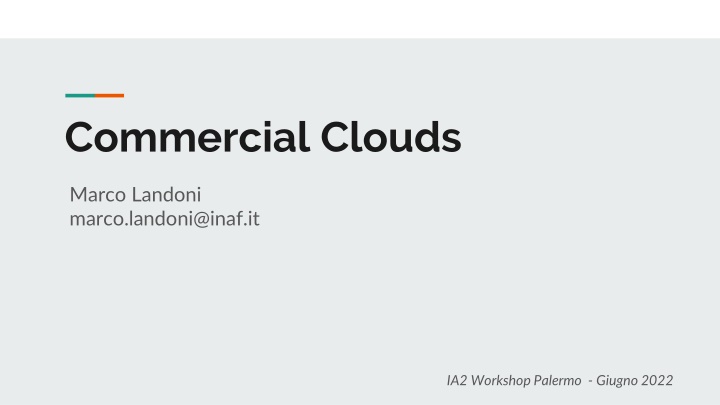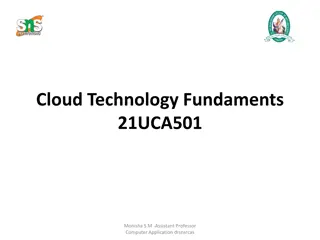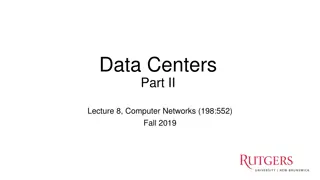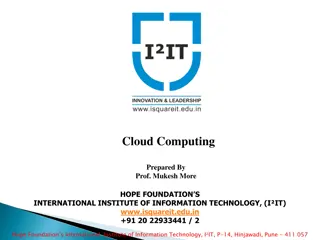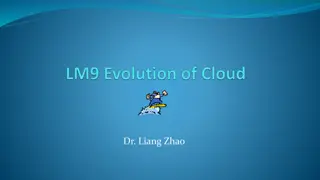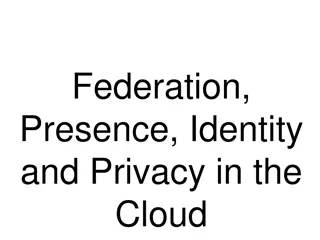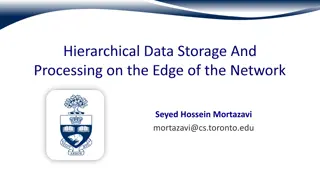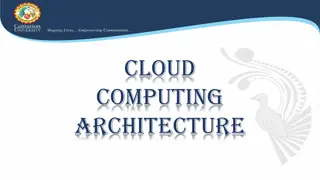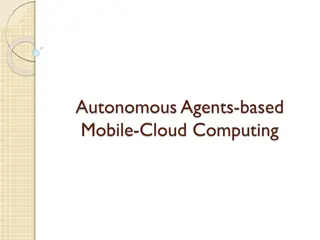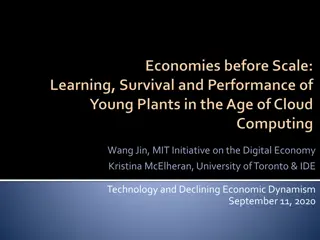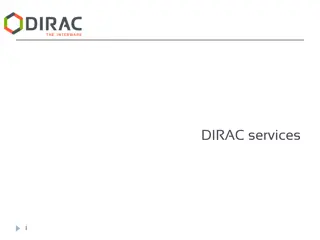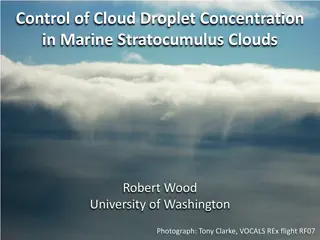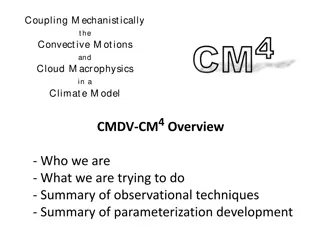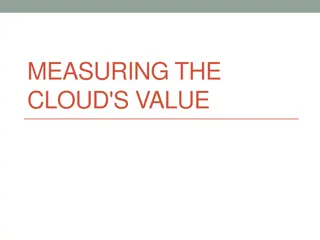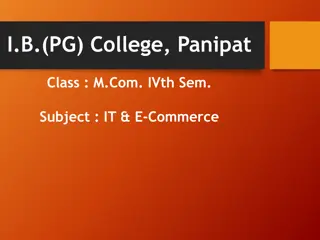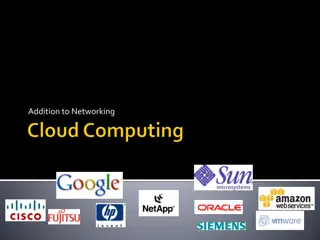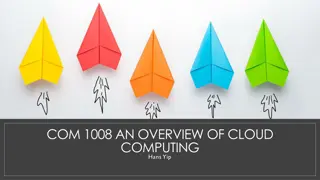Commercial Clouds: Enhancing Research Capabilities Through Cloud Computing
Introduction to the field of application of Commercial Clouds at the IA2 Workshop in Palermo. Exploring case studies on the use of AWS and Google Cloud at INAF, highlighting the benefits of leveraging commercial cloud services for mid-sized computational problems. Discussing typical examples of scenarios suitable for commercial clouds and the state-of-the-art services offered. Insight into different types of commercial clouds and a case study on the AWS call at ICT INAF in 2020. Accessing resources from the community, rapid resource allocation, and support offered. Reviewing the AWS experience through approved projects demonstrating the efficacy of cloud computing in research applications.
Download Presentation

Please find below an Image/Link to download the presentation.
The content on the website is provided AS IS for your information and personal use only. It may not be sold, licensed, or shared on other websites without obtaining consent from the author.If you encounter any issues during the download, it is possible that the publisher has removed the file from their server.
You are allowed to download the files provided on this website for personal or commercial use, subject to the condition that they are used lawfully. All files are the property of their respective owners.
The content on the website is provided AS IS for your information and personal use only. It may not be sold, licensed, or shared on other websites without obtaining consent from the author.
E N D
Presentation Transcript
Commercial Clouds Marco Landoni marco.landoni@inaf.it IA2 Workshop Palermo - Giugno 2022
Summary - - - - - Introduction Field of application of Commercial Clouds Case Study 1 - The AWS call @ INAF Case Study 2 - The Google Cloud test @ INAF Conclusion
Why Commercial Clouds ? An increasing number of mid/small size problems are arising in our Institution (and around). Those scenarios involves the use of resources typically larger than an high- end workstation but not justified in the context of large HPC/HTC facilities (e.g. CINECA, Pleiadi, etc) An overall buffer would allow to better allocate resources w.r.t. each scenarios.
Typical examples Large embarrassingly parallel simulations , data reduction that DO NOT require message passing Typically based on code easily portable on Docker containers Queueable with Batch Jobs or similar.
Few state-of-the-art offered services - - - - Serverless Computing (e.g. Lambda Function, Cloud Function) Machine Learning as a Service (MLaaS) Accellerated computing as a Service (or in-hardware computation) Containerisation, execution and orchestration.
Case 1 - The AWS call @ ICT INAF - In 2020, the INAF ICT issued a call to the community for using computational power offered with AWS. - 18 projects up to now have been approved. - Services used: Mainly compute, jobs and GPU.
Access to the resources from the community On demand call Rapid access to resources (2 days typical) Support offered
AWS Experience - a review Among the projects approved, a number of that seems to perfectly represent the philosophy behind the use and approach of Cloud Computing (not only commercial) in general:. - Use of Windows Based ray-tracing software (Zemax) in the context of ELT Maory project. Ultra High end cluster of workstations sporadically required on demand according to the foreseen reviews of the project. (Magrin et al 2021) Successfully completed Development and scale test environment for GPU based astrophysical codes (Covino et al 2022) Successfully completed Use of GPU as IaaS for simulations (Fabio Rossi et al 2021) Successfully completed Montecarlo Markov Chain simulation (EMCEE) in the context of gravitational waves data analysies (Salafia et al 2021, Nature) Successfully completed - - -
AWS Experience - a review of projects in progress There are also a number of projects, still ongoing, approved that are exploiting the platform. - Machine Learning Assisted Cosmology (Granett et al 2022). Use of GPU nodes for the training of Deep Learning Neural Networks with Tensorflow (on the context of Euclid) Machine Learning methods for GRB detection with AGILE (Parmiggiani et al 2022) - - Analysis of Juno/JIRAM limb spectra (use of parallel Jobs with containers for data reduction, Castagnoli et al 2022) Large GRB simulations for the Cherenkov Telescope Array (parallel Jobs, Nava et al 2021) -
Used core/hrs - Difficult to assess in terms of vCPU/hrs due to the heterogeneity of the offered machine However, applying a roughly estimation about 600.000 equivalent vCPU/hrs have been used Few kEUR spent, more available - -
Main technologies used - AWS EC2 (especially with Spot Instances) and AWS Jobs for orchestrating the runs and the Docker containers.
Storage No particular request (at the moment) for short/medium term storage IN general terms, Storage on the Cloud is easy and reasonable for long term, persistent storage that is not accessed (e.g. long term preservation) The cost for injecting the data in the sotrage (S3, EFS,...) is in general cheap (few cents for a GB) but egress are expensive (up to 0.10 EUR/GB on the cold line). A good solution of ultra-long term data preservation ?
Papers published 5 Papers (1 Nature) published in the first run (2020-2021) with the use of AWS platform, using only few kEUR of the allocated budget. Expected from the in-progress projects at least further 2-3 refereed papers on main journals. A successful experience that the ICT, according to the budget, plans to maintain in the foreseeable future.
More details: https://www.ict.inaf.it/computing/gcloud/ The Proof of Concepts with Google Cloud Platform
HTC workload Compute engine has been used (like AWS EC2) for tackling HTC workload on the platform. Yabi + GOFIO on GCP (Bignamini et al )
HTC + GPU Workload Adaptive Optics software and simulation on GCP (PASSATA, Agapito et a 2017) Architecture has been implemented successfully with Managed Group + Preemptible instances SLI configuration of the GPUs performed well with different hardware configuration (P100, Tesla K80, etc Overall price low (couple of kEUR for a whole MAORY simulation which cover about 1yr/work) GOOD candidate especially for GPU bounded application
HPC limitation No HPC workload or, in general, with high message passing (Taffoni et al 2019)
EOSC & others. - Do not forget that Cloud Computing is a computational paradigm from ideas to implementations to papers. No general preference is given for a commercial one. They are ready to use without overheads on proposals and can be accounted in the budget of a project. However, open and alternative, sometimes free, solution are (or will be) available in the future (GARR also is testing some Cloud Computing services) - -
Conclusions - Cloud computing (not only commercial) will become more important in the near future according to the increase demand of small/medium size problems required by scientist. With a small budget, can be used along with state-of-the-art HPC facilities (e.g. CINECA, PLEIADI, Tecnolopo, etc.) to better allocate resources, reduce the queue and adapt computational problem to each proper environment. Keep an eye also on non-commercial products that are becoming more and more interesting (stay tuned) - -
